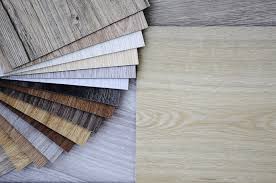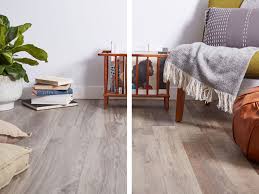Which is better vinyl or laminate flooring?
What is Vinyl Flooring?
Vinyl flooring is made from 100 percent plastic. This composition gives it superior resistance to moisture. When water sits on vinyl floors, even for extended periods of time, it won’t damage the surface. Vinyl’s water resistance makes it an excellent choice for rooms that are prone to moisture. For example, kitchens, bathrooms, laundry rooms, and basements.
What is Laminate Flooring?
Laminate is a synthetic product that simulates the look of real hardwood. It can have an authentic wood floor appearance that make it popular with homeowners who like the style of hardwood but want to spend less money on flooring. Although it is a budget-friendly flooring type, laminate does not perform well when it comes to moisture. Some types of laminate have water-resistant properties, but these flooring options are not waterproof and will become seriously damaged if water sits on them for an extended period of time.

Vinyl Flooring Pros and Cons
Pros
Some types of vinyl flooring are waterproof. For example, wood plastic and polymer composite (WPC) vinyl is waterproof. This is thanks to its composition of thermoplastics, wood flour, and calcium carbonate. It can be installed in areas where high moisture levels are present. Other waterproof vinyl floor options include stone plastic composite (SPC) vinyl, made from natural limestone powder, polyvinyl chloride, and stabilizer. It is also known as rigid core vinyl. You can install it over many types of flooring as a floating floor. When considering moisture exposure, in the vinyl vs laminate debate, vinyl flooring is a clear winner.
Historically, many people considered vinyl aesthetically inferior to laminate. Now, however, vinyl has come a long way when it comes to style choices. You can find vinyl flooring that mimics the look and feel of stone, tile, and even wood floors with realistic accuracy.
Cons
Vinyl has a longer lifespan and better overall durability than laminate. Don’t forget to factor in your budget, however. Vinyl flooring may be more expensive than laminate flooring, especially if you choose luxury vinyl flooring. Although it can last twice as long as laminate, vinyl flooring may involve a larger upfront investment.

Pros of Laminate Flooring
- Durable: Laminate flooring’s supreme durability makes it a good option for high-traffic areas or homes with kids and pets.
- Scratch resistance: Laminate has a strong wear layer that protects the floor from scratches, dents, wear and staining, all the things pets love to test our floors on.
- Realistic wood and stone looks: Laminate floor planks often have some surface detail to further mimic a natural hardwood look and can have the look and feel of a hand-scraped hardwood, embossed wood, distressed hardwood or come in textured or smooth. Unlike real hardwood, you’ll see consistent quality across all laminate flooring boards.
- Can resist some water: Advances in construction are improving laminate’s water-resistant capabilities. While it’s still not as waterproof as other wood-look options like vinyl flooring, most new laminate floors can withstand topical moisture. Proper installation helps keep water from seeping through the planks.
- Can be installed over radiant heating systems: You won’t find this feature with most hardwood flooring options.
- Easy to clean and maintain: Simply mop or sweep up messes as needed. No floor waxing is ever necessary.
- Easy to install: Laminate flooring is designed to be installed as a floating floor, meaning that it is not secured to the ground underneath, but rather “floats” by the means of an interlocking design.
- Easy to stand on for longer periods of time: Most laminate installations include underlayment, which can make the floor feel more comfortable underfoot.
- Cost effective: Laminate floors are an affordable alternative to hardwood floors. And when it comes to laminate vs vinyl flooring, laminate wins in the price category.
Cons of Laminate Flooring
- Not as water-resistant as vinyl flooring: While laminate flooring has come a long way in its water-resistant capabilities, it still cannot tolerate standing pools of water. Unlike vinyl, laminate’s water resistance works from top to bottom rather than bottom to top. If you have moisture issues with your subfloor, you’ll still need a vapor barrier.
- Not recommended for full bathrooms or basements: Since these areas are prone to leaks and flooding, you’ll want a more water-resistant floor. You can make your laminate floor more water resistant by installing an underlayment and vapor barrier as well as using the glue-down installation method.
- Sound: If installed poorly, laminate floors can create a hollow, empty sound. Every product comes with thorough installation instructions, and if you’re really worried, you can always hire an expert. Plus, a good underlayment can make for a quieter laminate floor.

Vinyl vs Laminate: The Similarities
To summarize, vinyl is a better choice when you need water resistance, lifespan, and durability in your flooring. Meanwhile, laminate is preferable if you want a more stylish appearance, lower costs, and a comfortable feel underfoot.
Despite their differences, laminate and vinyl are also similar in a number of ways, including the following:
- Ease of Installation: If you need a foam underlayment for laminate or decide to install vinyl sheeting, you may need the help of professionals to complete the installation. However, both laminate and vinyl come in planks that lock together as a floating floor or almost any type of subfloor, giving you the option for an easy DIY installation with either flooring type.
- Maintenance: Vinyl and laminate are both easy to keep clean. Simply mop, vacuum, or sweep as needed. You don’t need special cleaning products or machinery to keep these floors in good shape.
- Cost: Laminate is sometimes found at lower prices compared to vinyl. This depends on what type of style and features you’re looking for. With vinyl vs laminate, the price is relatively comparable. Both are considered to be two of the most budget-friendly flooring options.
Durability & Stability
Before discussing the durability and stability of premium vinyl vs. laminate, we should define the terms, as they seem similar:
Durability: Hardness of the flooring—especially its topmost wear layer. The more durable a flooring solution is, the more use it can take.
Stability: Governed by the thickness of the whole and/or makeup of layers and quality of materials. Stable flooring material holds its shape and size against moisture and/or climate changes.
Both vinyl and laminate are constructed in similar ways, generally with a wear layer, photographic image and a backing system. The composition, however, varies.
Laminate is typically made from HDF or high-density fiberboard, which is made up of recycled hardwood. Laminate is not waterproof so it is not recommended to install this product in high-moisture or humid areas or places that often have spills like in supermarkets or in restaurants. Laminate is best to install in climate-controlled areas.
Vinyl, however, is a much different story. Parterre vinyl in particular is a hard, closed-cell vinyl allowing for the product to be more water resistant and ideal for higher-moisture areas. A sealant is not required for vinyl, but is recommended for high-moisture areas for an added layer of protection.
Laminate is a hard product, but tends to also be hollow. It is important that the subfloor underneath is smooth and even. Vinyl is ideal for heavy trafficked areas due to its ability to expand and contract. And, both are very easy to clean. Read more about LVT for high-traffic areas.